Week 8 - AEE Summary
| Site: | Unitec Online |
| Course: | ENGGMG7109 - Resource and Environmental Management 2022 |
| Book: | Week 8 - AEE Summary |
| Printed by: | Guest user |
| Date: | Monday, 1 December 2025, 2:50 PM |
Table of contents
- 1. AEE Summary
- 2. Environmental Management Plans
- 2.1. Managing Environmental Effects
- 2.2. Step 1 - Evaluation
- 2.3. AC36 Plans
- 2.4. Step 2 -Quantifying Effects
- 2.5. Construction Environmental Management Plans (CEMP)
- 2.6. Special Effects Management Plans
- 2.7. WVT– application docs
- 2.8. Construction effects vs. Operational effects
- 2.9. Step 3 - Monitoring
- 2.10. Partnership with Mana Whenua
- 2.11. Benefits of EMPs
1. AEE Summary
 An AEE identifies who you should consult and, if required, from whom you should obtain written approval. It is used as the basis for the council’s decision on whether to notify and grant an application, and, if granted, whether to impose any conditions to address any outstanding effects. The final outcome of the AEE process is an accurate and objective statement about the effects of your proposal on the environment. This statement will have taken into account whether the proposal has avoided, mitigated or remedied any adverse effects on the environment and people.
An AEE identifies who you should consult and, if required, from whom you should obtain written approval. It is used as the basis for the council’s decision on whether to notify and grant an application, and, if granted, whether to impose any conditions to address any outstanding effects. The final outcome of the AEE process is an accurate and objective statement about the effects of your proposal on the environment. This statement will have taken into account whether the proposal has avoided, mitigated or remedied any adverse effects on the environment and people.The environment includes-
(a) Ecosystems and their constituent parts, including people and communities; and
(b) All natural and physical resources; and
(c) Amenity values; and
(d) The social, economic, aesthetic, and cultural conditions which affect the matters stated in paragraphs (a) to (c) of this definition or which are affected by those matters.(a) Any positive or adverse effect; and
(b) Any temporary or permanent effect; and
(c) Any past, present, or future effect; and
(d) Any cumulative effect which arises over time or in combination with other effects
regardless of the scale, intensity, duration, or frequency of the effect, and also includes—
(e) Any potential effect of high probability; and
(f) Any potential effect of low probability which has a high potential impact.
1.1. Types of Consent
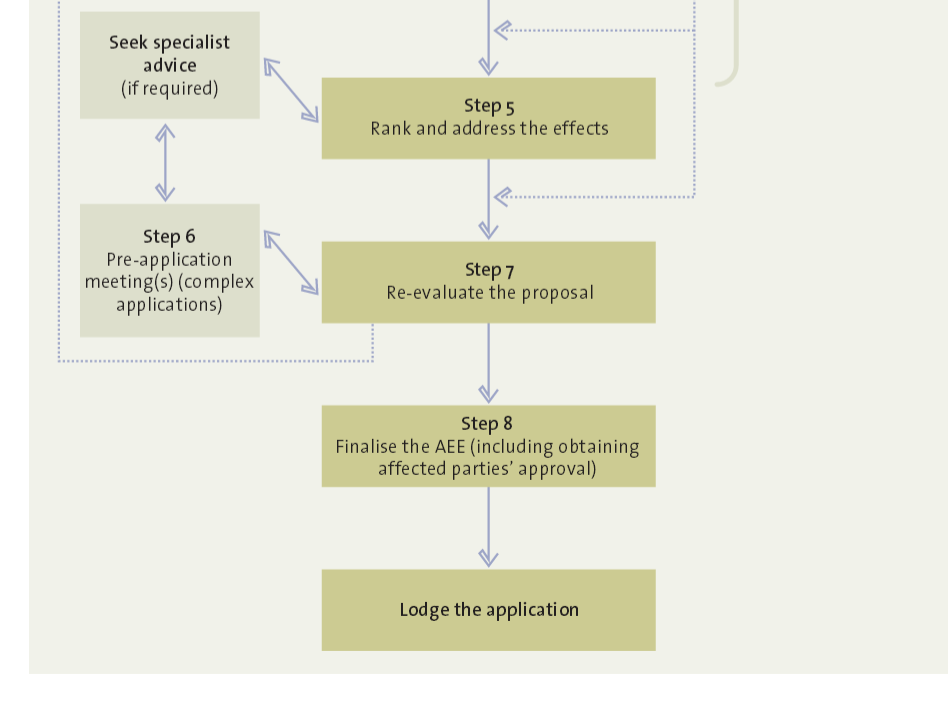 What type of consent do I need?
What type of consent do I need?
There are many different types of consent as described below. These descriptions are listed in order of an increasing level of time and commitment to providing a full, detailed AEE.
Permitted Activities
A council can grant or decline an application for a discretionary activity. If granted, it can impose conditions in relation to any matter that helps to control any of the activity’s potential adverse effect.
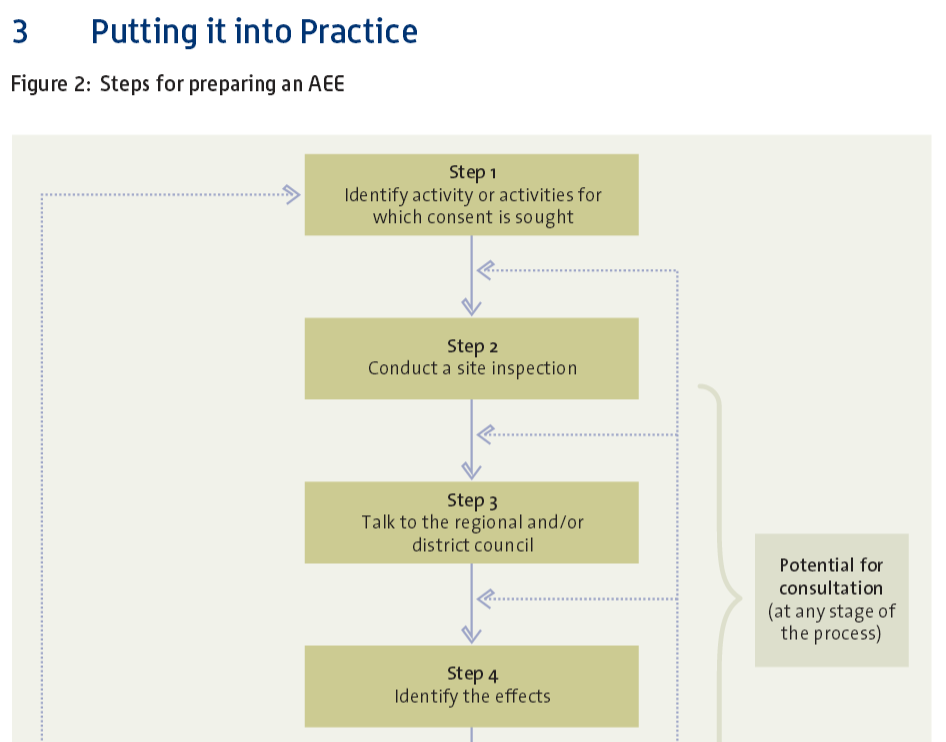
1.2. Detailed Steps
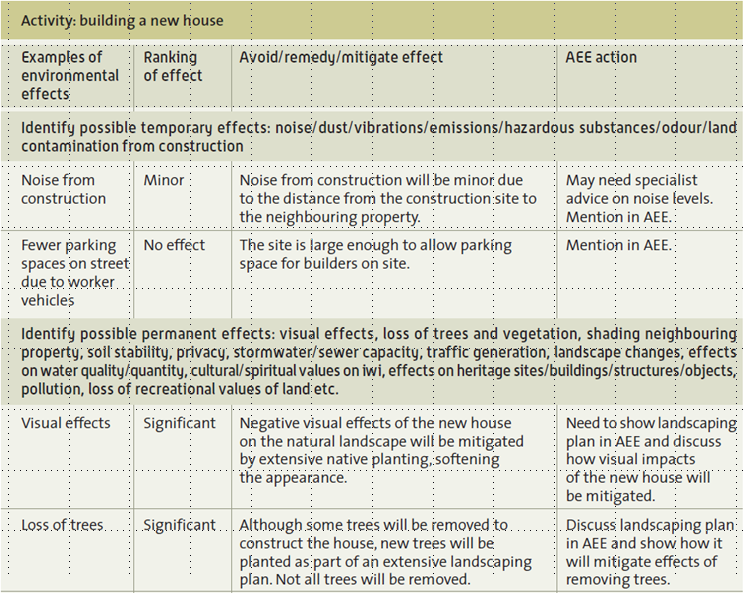 The first step in the creation of an AEE is the proposal description as described below.
The first step in the creation of an AEE is the proposal description as described below.- Location
- Extent
- Scale
- Construction elements
- Physical changes to the build and natural environment.
This section should be followed by:
- positive or negative
- temporary or permanent
- past, present or future
- cumulative (occur over time or in combination - with other effects)
- of high probability
- of low probability but high impact.
This section may include:
A landscape assessment, a social Impact assessment, CPTED assessment and a number of water and soil quality assessment tools such as Macroinvertebrate Coomunity Index (MCI) or compliance with the ANSECC guidelines for sediment quality.
3. Where the above effects are likely to be significant, a description of available alternatives.
- Locations
- Scale
- Method
1.3. Further Steps
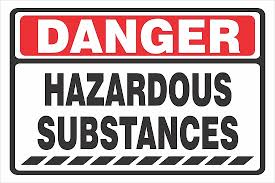 4. A discussion of the risk to the environment from hazardous substances and installations.
4. A discussion of the risk to the environment from hazardous substances and installations.- Construction
- Operational
- Storage
- Accidental Discharge
6. A description of how the adverse effects may be avoided, remedied or mitigated.
- Sediment Control Plans
- Noise Management
- Landscape Plan
- Alternative Methods
- Remediation Plans
- Environmental Management Plans
- Form part of an EMS or
- A stand-alone action plan.
What is an environmental management system?
Part of an organisation’s management system used to develop and implement its environmental policy and manage its environmental aspects and impacts.
(AS/NZS ISO 14001:2004 cl. 3.8)
1.4. Consultation
 Consultation is a very important step in the creation of an AEE.
Consultation is a very important step in the creation of an AEE.
Where do I start?
- a brief written description and plans of your idea/proposal
- a tentative assessment of environmental effects
- measures you would propose to reduce the extent or impact of those effects.
- by letter (usually) in the first instance with an offer of follow-up contact to discuss the proposal in the following days
- by telephone (where possible) to confirm that they have received the information you sent, and to arrange further communication (preferably face-to-face) to determine any issues
- at an on-site meeting, where you explain your proposal.
The final step of this process is detailed below:
8. Where an effect needs to be controlled, a discussion of how it can be controlled and whether it needs to be monitored. Where appropriate, a description of how this will be done and by whom.
1.5. Final Points
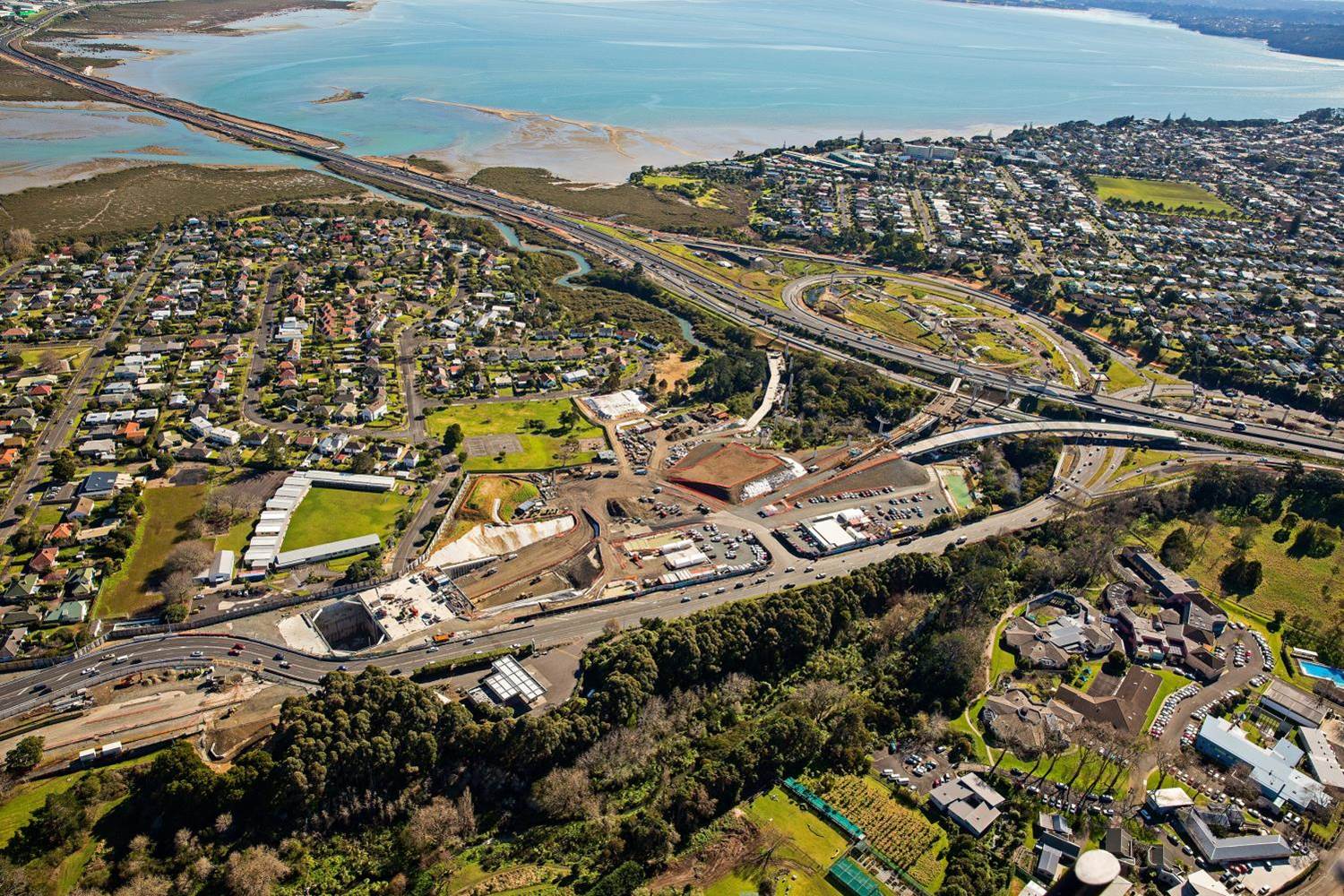 Some final points to remember:
Some final points to remember:
- A full description of the proposal, including the site and locality (including a site plan and plans of your proposal)
- A description of the environmental effects, including the significance and nature of the effects (address specific environmental effects that you have identified as well as referring to issues identified in the district and/or regional plan)
- A description of alternatives to avoid, remedy or mitigate any significant environmental effects.
-
an assessment of any risks to the environment that may arise from hazardous substances and/or the discharge of contaminants.
- A record of any consultation, including names and views of people you have talked with.
- A discussion of any effects that may need to be controlled or monitored, how the control or monitoring will be carried out and by whom.
2. Environmental Management Plans
What are Environmental Management Plans (EMPs)?
Plans or procedures to deliver the intended environmental outcomes of construction, operation and maintenance activities undertaken for a civil's project

Waterview Tunnel, photo kindly shared by
Ray Chang, 2020
2.1. Managing Environmental Effects
- What is there at the moment?
- What is the quality of this resource?
- What are the effects likely to be?
- What is the nature/timescale of effects?
- Check what has changed.
- What further action is required?
2.2. Step 1 - Evaluation
36th America’s Cup
Works planned included consenting, design and construction of the infrastructure, sediment dredging, installation of breakwaters and pontoons, Hobson Wharf extension, Halsey Wharf conversion to house Emirates Team New Zealand.
Transforming waterfront, e.g extension to Silo Park & new waka-inspired shade structure, Te Nukuao

America’s Cup Assessment – image kindly shared by Ray Chang, 2020
2.3. AC36 Plans
Air Quality – Design Standards
- MFE – Good Practice Guide for Assessing and Managing the Environmental Effects of Dust Emissions (2001)
- AS/NZ 3580.1.1: 2007 Method for sampling and analysis of ambient air – Guide to siting air monitoring equipment
- National Environmental Standard for Air Quality (AQNES)

2.4. Step 2 -Quantifying Effects
Waterview tunnel plan

2.5. Construction Environmental Management Plans (CEMP)
CEMP
The CEMP defines details of who, what, where, and when environmental management and mitigation measures are to be implemented. The CEMP covers the anticipated construction elements for the stage of work and represents a framework of principles, environmental policy, objectives, and performance standards as well as processes for implementing good environmental management.
Environmental Sub Plans
Detailed environmental management plans (sub-plans) required to manage specific effects (e.g. construction air quality, noise, vibration, etc.) of the proposed work are provided as appendices to this CEMP. Contained within each of the sub-plans are the associated monitoring and reporting requirements and "site specific" plans (e.g. noise, vibration, traffic, and erosion and sediment control). The suite of management plans required by consent conditions under CEMP.3 is shown on figure 2 and table 2.
Identify the likely hazards and risks on the site during construction in terms of potential environmental damage.
CEMP
overarching document

2.6. Special Effects Management Plans
- Certain effects need even more specificity to provide comfort
- Site-Specific Noise Management Plans
- Managed by the over-arching Construction Environmental Management Plan and sub plans
2.7. WVT– application docs

2.8. Construction effects vs. Operational effects
Construction effects may include:
Noise
- Beeping
- Conveyor belt operation
- General site works
- Dust
- Sedimentation
- pH, nutrients, metals, etc.
- Exposure of contaminated soils

2.9. Step 3 - Monitoring
Construction Phase Requirements for AC36 include:
- Monthly monitoring of water quality
- Monitoring of water quality in response to storm events
- Review of ecological assembly within the Inner Viaduct Harbour
- Baseline samples
- Post-construction samples (Monitor potential change in water quality / ecology as a result of new structures in the CMA)
- Technical report evaluating changes

America’s Cup Venue pre-construction – image kindly shared by Ray Chang, 2020
2.10. Partnership with Mana Whenua
Wynyard Edge Alliance (WEA) partnered with mana whenua to construct the infrastructure for AC36.
19 iwi/hapū invited to establish the America’s Cup Kaitiaki Engagement Plan (ACKEP) and had a major contribution to project’s environmental management principles.
Principles of partnership, reciprocity, active protection, and equity honoured.

Activities
affecting cultural values
Mana whenua were involved in the
preparation and implementation in a range of management plans. Of particular
concern:
2.11. Benefits of EMPs
- Outcomes based solution
- Promise to achieve a certain result (might require time)
- Allows flexibility in how you achieve compliance with a parameter
- Can be altered depending on circumstances

Proposed mitigation plan – image kindly shared by Ray Chang, 2020